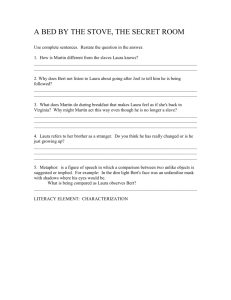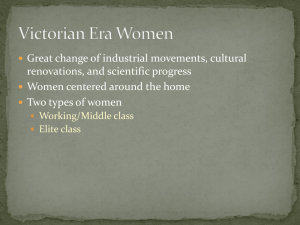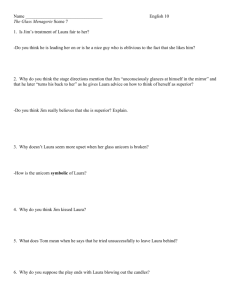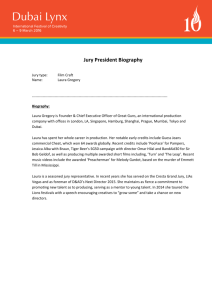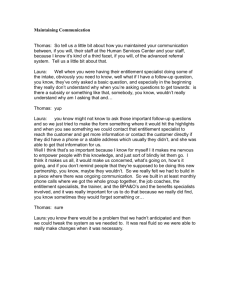Lolly Willowes essay
advertisement
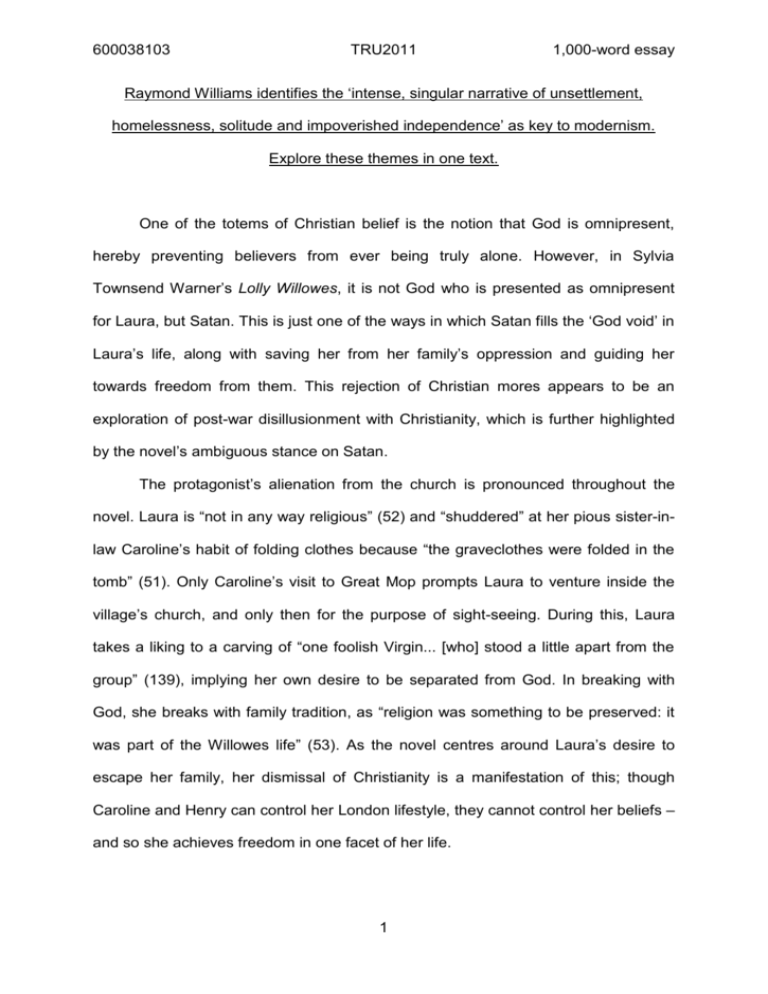
600038103 TRU2011 1,000-word essay Raymond Williams identifies the ‘intense, singular narrative of unsettlement, homelessness, solitude and impoverished independence’ as key to modernism. Explore these themes in one text. One of the totems of Christian belief is the notion that God is omnipresent, hereby preventing believers from ever being truly alone. However, in Sylvia Townsend Warner’s Lolly Willowes, it is not God who is presented as omnipresent for Laura, but Satan. This is just one of the ways in which Satan fills the ‘God void’ in Laura’s life, along with saving her from her family’s oppression and guiding her towards freedom from them. This rejection of Christian mores appears to be an exploration of post-war disillusionment with Christianity, which is further highlighted by the novel’s ambiguous stance on Satan. The protagonist’s alienation from the church is pronounced throughout the novel. Laura is “not in any way religious” (52) and “shuddered” at her pious sister-inlaw Caroline’s habit of folding clothes because “the graveclothes were folded in the tomb” (51). Only Caroline’s visit to Great Mop prompts Laura to venture inside the village’s church, and only then for the purpose of sight-seeing. During this, Laura takes a liking to a carving of “one foolish Virgin... [who] stood a little apart from the group” (139), implying her own desire to be separated from God. In breaking with God, she breaks with family tradition, as “religion was something to be preserved: it was part of the Willowes life” (53). As the novel centres around Laura’s desire to escape her family, her dismissal of Christianity is a manifestation of this; though Caroline and Henry can control her London lifestyle, they cannot control her beliefs – and so she achieves freedom in one facet of her life. 1 600038103 TRU2011 1,000-word essay Her solitude is emphasised throughout the novel, and her desire for it prompts the novel’s progression. As a child she does not “have the companionship of girls of her own age” (17) and is “nonchalant” (15) when tied to a tree by her brothers and forgotten – ironically, the tree in question is a “Bon Chrétien pear tree” (16), translating as ‘good Christian’. Even as she matures, she “disliked going out” and “seldom attended any... parties” (25), and her move to Great Mop comes as a result of wanting to be independent as “a single, middle-aged woman with an income of her own” (102). ‘Solitude’ is effectively synonymous with ‘freedom’ for Laura, who pejoratively considers her family her “moorings” (72), hence its importance to her. “Her battle for what might be called ‘a room of her own’” (Poulos Nesbitt, 451) overrides her brother’s will and the financial difficulties resulting from his rash investment of her inheritance. However, the implied solitude Laura eventually enjoys when exploring Buckinghamshire is misleading. On several of her walks, nature is personified through its communication with her. The wind engages in this – “‘Hoo! You devil,’ said the wind. ‘Have you come out to join us?’” (107) – and she appears to seek the approval of the woods more than the people in the village. One reason she resents her nephew Titus for living in Great Mop is because “the woods judged her by her company, and hushed their talk as she passed by with Titus” (161). Although they oppress her as her family do – “She heard the mutter of heavy foliage. ‘No!’ the woods seemed to say, ‘No! We will not let you go.’” (165) – it appears to be a more welcome oppression, as she continues to prefer the ‘company’ of the woods to that of her nephew. Such an emphasis on the nature’s personification could infer that Laura is hallucinating, until it is revealed that “couched within the wood... had lain the Prince 2 600038103 TRU2011 1,000-word essay of Darkness” (170). From here on, she realises that Satan has been following her for years, “near at hand but out of sight” (177). This phrase has parallels with the Bible verse “Am I a God at hand, saith the Lord, and not a God afar off?” (King James Bible, Jer. 23:23), stressing the novel’s replacement of God with Satan. The replacement is explicitly demonstrated through the fact that Mr Jones, Great Mop’s resident clergyman, is a warlock, and in league with Satan. Satan also fills some of the duties that the Christian God would usually undertake. He manifests himself in order to help Laura in a time of need, as God does – “[God] will fulfil the desire of them that fear him: he also will hear their cry, and will save them” (Psalms, 145:19) – and the only payment he requests is that she gives her life to him, arguably following the Christian model of salvation through belief, that “by grace are ye saved through faith... it is the gift of God” (Eph 2:8). This Satanic salvation is considered in the text, for “As Laura muses, there “remaineth a rest” for the people of Satan as for those of God” (Shin, 723). While these parallels are important, it is similarly important to note that Satan remains a sinister and semi-disempowered alternative to God. Despite Laura naively considering him a “black knight... succouring decayed gentlewomen” (234), Satan is “a representative of a larger entity with motivations that are not entirely predictable” (Poulos Nesbitt, 465), betrayed by details such as “a slightly malevolent smile” (Townsend Warner, 223). While he appears to have been omnipresent throughout Laura’s life, albeit as a hidden presence, he is denied full omnipresence through his corporeality, as “It is clear that if God has a body then it must be the case that he is spatially locatable... if a body is located at a certain place... then there are places where it is not. But if a being is omnipresent, then there is no place where it is not” (Dyck, 86). 3 600038103 TRU2011 1,000-word essay Essentially, Laura’s journey is representative of that of many post-war Britons. As Laura breaks with the traditional church to seek her own beliefs, so too did enough Britons for there to be a “a decline in church attendance” (Fekete, 4). This was for several reasons. There was a collective disillusionment with faith following the war, as “After the Great War many survivors of WWI felt that ‘a loving God’ had died in the trenches” (Karpova, 2), but the 1920s also saw the rise of Modernism, reform and radicalism, leading many to feel that the church was too staid and outdated an institution for the modern age. If the former explanation is to inform a reading of the text, however, it would be that the figure of Satan is actually that of God; albeit a twisted one who allowed the atrocities of war. Perhaps, then, the text is an allegory for an increasing consciousness among the public of the dubious goodness of God. I do not believe that Townsend Warner advocates Satanism within the text, despite the fact that she paints it in a more engaging light than she does Christianity. Instead, she is recording the disenchantment and cynicism surrounding spirituality in the 1920s, and exposing flaws within the accepted idea of God. 4 600038103 TRU2011 1,000-word essay Works Referenced Dyck, Grace M. "Omnipresence and Incorporeality." Religious Studies: 13.1 (March, 1977): 85-91. JSTOR. Web. 19 Feb. 2012. Fekete, Peter. "Social Trends in Britain During the 1920s." Black's Academy Co. Ltd, 2003. PDF. The Holy Bible, Authorized King James Version. Grand Rapids: Zondervan, 2009. Print. Karpova, Lisa. "Capitalism and Christianity in British Society." PRAVDA.Ru. 30 Sept. 2011. Web. 20 Feb. 2012. Poulos Nesbitt, Jennifer. “Footsteps of Red Ink: Body and Landscape in ‘Lolly Willowes’.” Twentieth Century Literature: 49.4 (Winter, 2003): 449-471. JSTOR. Web. 19 Feb. 2012. Shin, Jacqueline. "Lolly Willowes and the Arts of Dispossession." Modernism/modernity: 16.4 (November 2009): 709-725. Project Muse. Web. 20 Feb. 2012. Townsend Warner, Sylvia. Lolly Willowes. London: Virago Press Ltd, 2000. Print. 5

